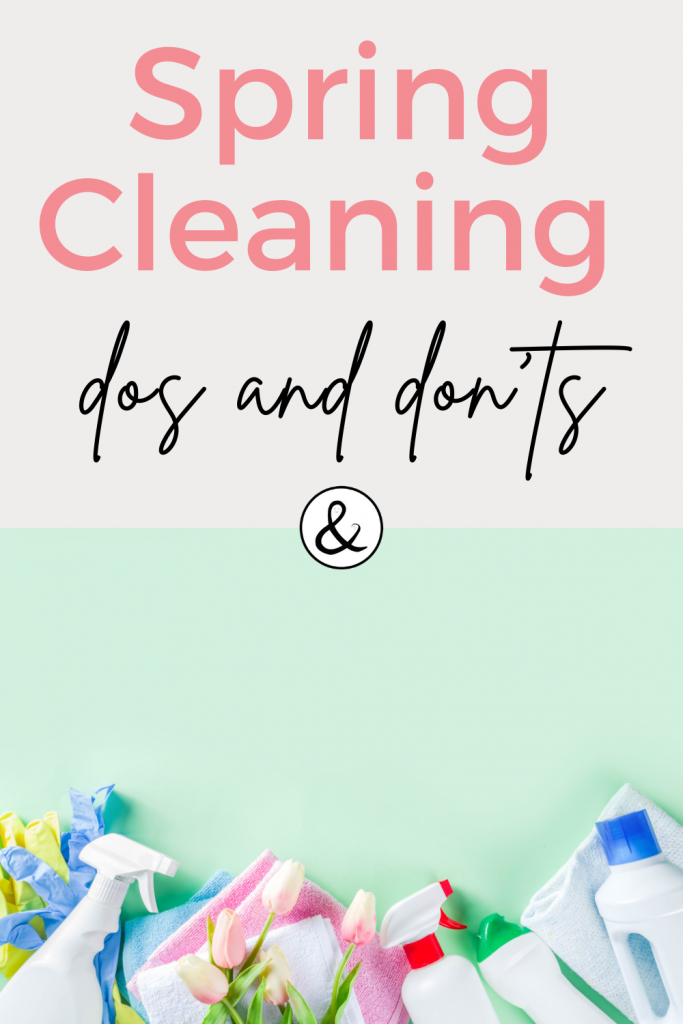This post may contain affiliate links. Click here to read my affiliate disclaimer policy.

Each year, spring rolls around more quickly than we could have ever imagined. With the new season, comes the opportunity to clean out your home. But this year, considering the amount of time each of us has spent in our homes this year, more than a deep clean may be necessary. If you plan on tackling spring cleaning this year, take a look at this helpful guide on the dos and don’ts of spring cleaning.
Additionally, there seems to be much greater importance on the way you spring clean. You should look at the things you own and use every day and if you are doing so in a sustainable way.
The Dos and Don’ts of Spring Cleaning
Do: Deep Clean
One thing you should absolutely add to your spring cleaning regimen is a deep clean of your entire home. You can start by separating tasks by room and then tackling a basic cleaning checklist based on that room’s specific needs.
For example, you may have carpeting on the second floor of your home while the first floor has hardwoods. This means that each floor will require different types of cleaning. Furthermore, your kitchen will need cleaning of appliances while your living room may have a hard-to-reach ceiling fan. By using a room-by-room spring cleaning checklist, you can better prioritize your time and better tackle your deep clean routine.
Don’t: Use Harmful Chemicals
Having harmful chemicals in your home can be a major issue, especially if you have small children or pets. Toxicity levels in cleaning products can create hazards with immediate or even long-term effects, ranging from poisoning to respiratory issues. Harmful chemicals you should steer clear of include:
- Carcinogens – cancer-causing substances
- Endocrine disruptors – can bring about infertility, birth defects and even obesity
- Neurotoxins – if misused, can cause headaches and memory loss
So, what should you use instead of harmful cleaning chemicals? Luckily, there is a great range of healthy home products you can shop from. You can even get rid of mold naturally, which means there’s much less need for harsh chemicals than you may have previously thought. Being mindful of the chemicals you bring into your home is the best way to ensure your spring cleaning routine is both functional and safe.
Do: Recycle
Recycling is one of those things that is both complicatedly simple and simply complicating. From what you can recycle to what you should trash, what can be put out on your curb and what you need to bring to a facility, or even separating your recycling so it is properly disposed of, the process of recycling can get confusing!
Here are some common goods that are often confused during the recycling process:
- Appliances – Did you just take advantage of your home warranty to replace your old devices with the latest and greatest in appliance technology? The best way to recycle appliances is to donate or sell them if they are still in good working order. However, if they are beyond repair, you will need to arrange to have them delivered to your local recycling center so the metal can be salvaged and processed.
- Plastic Bags – While some states have undergone a plastic bag ban, others are still catching up. Either way, you may still be inundated with plastic bags at some point or another. Note, this is not an item you should add to your curbside bin, as they contaminate other items that could be recycled. Instead, look into properly recycling them anywhere they are accepted, like at grocery stores or recycling centers.
- Food & Beverage Containers – Not sure what can be recycled in your mix of food and beverage containers? The key is to look for the recycling stamp on the side or bottom of the packaging. Some communities allow more containers than others, so for a more detailed list of what you can recycle, check locally to what’s accepted in your area.
Don’t: Trash
Waste pollution is a serious problem in today’s society. With the rapid rate of landfills overflowing throughout the country, taking the time to do your part in preventing trash buildup will make a huge difference. Of course, there are some things you should and must trash, especially if it will contaminate your recycling bins. However, there are some alternatives you can do to trashing most household items.
For example, rather than putting old clothing in the trash, you could donate it to a local shelter. Even if you have old sheets that are ruined, look for other possible uses like animal shelters. And, for things that are biodegradable, you could even compost! At the end of the day, if you must trash, be aware of what can be reused or recycled instead of sitting in a landfill.
Do: Paint
Sometimes, a new view can bring about a whole new perspective! With a fresh coat of paint, your home can feel brand new again without undergoing any major renovations.
The first thing to consider when choosing a paint color is the feeling you would like to invoke. Believe it or not, the color of your walls can completely change your mood, so be careful not to choose hues that induce stress or have a negative effect on your home’s resale value. Choosing tranquil colors like white, gray or blue is sure to make your home feel a little cleaner. Alternatively, going with bold colors like yellow or red may have the exact opposite effect!
One other thing to keep in mind while painting your home is the negative effects of lead paint. Lead paint is most prevalent in older homes and can have detrimental effects on a person’s health. You can test for lead paint by using a kit that examines a small sample from your wall. Sometimes, you can cover the lead paint with encapsulation and repainting. If you determine that lead paint is present in your home, consult with a professional to see if simply layering over the previous paint job is safe to do.
Don’t: Renovate
After going over your home with a fine-tooth comb, you may have noticed some of your spaces are ready for a facelift. But by starting with paint, you can save a lot of dough on something that just needed a refresh rather than a renovation. Not only that, but you can further prevent waste pollution by avoiding major renovations. Did you know that a third of the country’s solid waste consists of building debris? Keep your carbon footprint in mind before undertaking any large projects like tearing down walls.
If you must make serious changes, consider only making those that will contribute to saving more energy. This can include investing in energy-efficient windows or doors, a new HVAC system that will heat or cool your home more easily, or even putting some money into alternative energy sources like solar panels. With the help of a solar loan, you can receive financial assistance to fund sustainable improvements for your home.
Spring Cleaning Guide
With these useful dos and don’t of spring cleaning, you will be well on your way to a clean home without creating extra work or stress in the process.
Amazon and the Amazon logo are trademarks of Amazon.com, Inc, or its affiliates.





